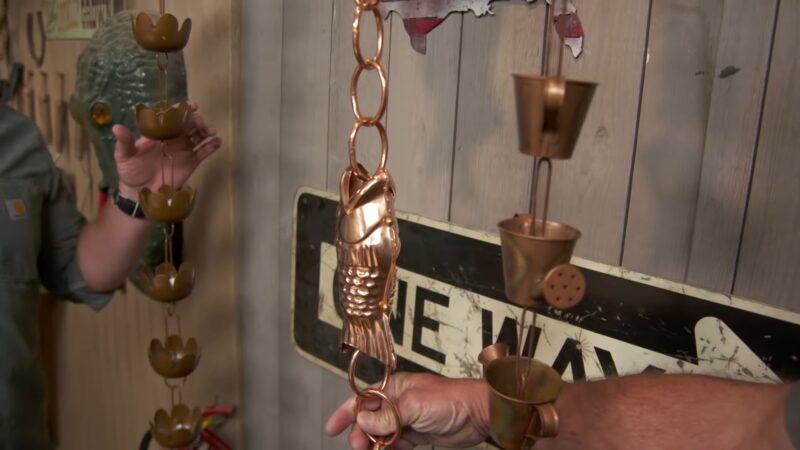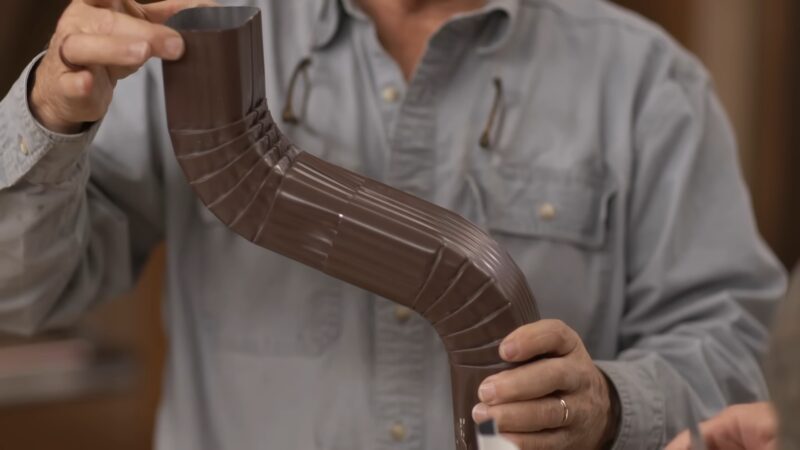It was during a trip to Japan that I first encountered the beauty of rain chains. Having lived in homes with both downspouts and rain chains, I’ve had my fair share of experiences, and that sparked my quest to understand which is truly better. Now, I want to help you as well.
The Verdict: What’s Better?

The age-old debate between form and function comes to the fore when choosing between rain chains and downspouts.
If aesthetics and a touch of artistry are high on your list, rain chains are the way to go. They add charm and can be a conversation starter.
However, if you live in an area with heavy rainfall or snow and are more concerned about durability and efficiency, downspouts are the clear winner.
A Middle Ground
Who says you have to choose? Many homeowners have found a balance by installing rain chains in more visible areas, like the front of the house, and using downspouts in less conspicuous locations. This way, you get the best of both worlds – functionality and beauty.
The Basics of Rain Chains

Rain chains, often seen in traditional Japanese homes, are a decorative alternative to the conventional downspout. Not only are they aesthetically pleasing, but they also transform the monotonous drip-drop of rain into a delightful water feature.
Installation and Maintenance
Installing rain chains is fairly straightforward, often requiring no more tools than a conventional downspout. The chain hangs from a hole in the gutter and directs water down into a ground drain or a collection barrel.
Maintenance is relatively easy. Due to its open design, debris is less likely to get trapped, but occasional cleaning and checking for wear and tear is advised.
Introduction to Downspouts

Downspouts are an integral part of the conventional gutter system. They ensure that rainwater is directed away from the building’s foundation, thus preventing potential damage.
Design and Efficiency
At first glance, these may seem purely functional, but they come in various styles and materials. From rounded to rectangular, downspouts can be tailored to match a home’s aesthetic. In terms of efficiency, they are unmatched.
Designed for volume, they can handle heavy rainfall with ease, ensuring water is quickly moved away from your home.
Installation and Upkeep
Downspouts require proper installation to function at their peak. This includes ensuring a slope for effective water flow and securing the downspout to the side of the building. Maintenance is a bit more hands-on compared to rain chains.
Leaves, twigs, and other debris can clog the downspout, so regular cleaning, especially after storms, is crucial.
Comparative Benefits
When it comes to choosing between rain chains and downspouts, understanding the advantages of each can be pivotal in making an informed decision.
| Aspect | Rain Chains | Downspouts |
|---|---|---|
| Pros | Decorative and enhances the beauty of any home with its intricate designs. | Simplistic design that can blend with virtually any architectural style. |
| Produces a soothing sound as water trickles down, which many find calming. | Quiet operation even during heavy rainfall. | |
| Less likely to get clogged due to its open design. | Sturdy and can handle heavy rain and other harsh weather conditions. | |
| Offers a wide variety of designs, materials, and customization options. | Color and shape can be tailored to fit a home’s aesthetic. | |
| Cons | Might get overwhelmed during heavy rainfalls, leading to water spillage. | Designed to handle large volumes of water efficiently. |
| Might wear out faster in areas with heavy snow or strong winds. | Typically more durable and resistant to various weather conditions. | |
| Tends to be more expensive, especially for intricate designs. | Generally less expensive and widely available. | |
| May require additional accessories or adaptors for installation. | Requires correct sloping and securing to function optimally. |
Aesthetics vs. Functionality
Rain chains are undoubtedly more aesthetically pleasing. Their intricate designs can enhance the exterior of any home, and the sound of water trickling down them can be quite soothing.
On the other hand, downspouts are built for function. While they can be tailored to fit the look of a house, their primary aim is efficiency in directing large volumes of water away.
Environmental Considerations
Both rain chains and downspouts can be environmentally friendly when paired with a rain collection system. However, rain chains offer a slight edge as they reduce the speed of water, decreasing erosion in garden areas. Downspouts, if not directed correctly, can lead to soil erosion due to the forceful flow of water.
Cost Analysis

Understanding the cost implications of both options can be a decisive factor for many homeowners. After all, while we all want our homes to look beautiful, we also want value for our money.
Initial Investment
Rain chains, given their decorative nature, can sometimes be more expensive than standard downspouts, especially if you opt for designs with intricate detailing or premium materials. Downspouts, being more common and mass-produced, typically come with a lower price tag for standard designs and materials.
Long-Term Value
While downspouts might seem cheaper initially, potential clogging and subsequent maintenance or repairs can add up over time. Rain chains, with fewer issues related to blockages, might save homeowners money in the long run, provided they’re well-maintained and installed correctly.
Durability and Longevity

Longevity is a crucial factor. Nobody wants to replace parts of their home’s exterior frequently, so understanding which option might stand the test of time is essential.
Materials and Wear
Rain chains, often made from metals like copper, brass, or stainless steel, can develop a natural patina over time, which can be aesthetically appealing. However, in areas with heavy snow or strong winds, they might wear out or break faster.
Downspouts, typically made from aluminum, vinyl, or steel, are sturdier and can withstand harsher weather conditions with ease.
Weather Resilience
Downspouts are undoubtedly more resilient in diverse weather conditions. They are designed to handle heavy rainfall, snow, and even hail. Rain chains, while beautiful, can get overwhelmed with heavy water flow or freeze in colder climates, which can impact their longevity.
What About Adaptability?

While both rain chains and downspouts serve a functional purpose, it’s essential to consider how they fit into the overall aesthetic of your home.
Traditional vs. Modern Homes
Rain chains, with their origin in Japanese architecture, fit beautifully with homes that have a traditional or oriental design. That said, modern designs of rain chains have emerged, making them adaptable to contemporary homes as well.
Downspouts, given their simplistic design, can seamlessly blend with virtually any architectural style, from Victorian to ultra-modern.
Customization Potential
Rain chains offer more room for customization. From the choice of material to the design, homeowners can select something that truly resonates with their personal style. Downspouts, while customizable in terms of color and shape, don’t offer as much diversity in design.
FAQs

Are There Any Noise Concerns with Rain Chains During Heavy Rainfall?
Yes, during heavy rainfall, rain chains can produce a more noticeable sound as water cascades down the links or cups. While some homeowners love this soothing sound, akin to a natural water feature, others might find it louder than the almost silent operation of a traditional downspout.
Can I DIY Install Both or Do I Need a Professional?
While both rain chains and downspouts can be installed as a DIY project, it’s essential to ensure correct installation to prevent water damage. Downspouts, in particular, require careful attention to ensure proper water flow away from the foundation.
If unsure, it’s always best to consult or hire a professional.
How Often Should I Replace These?
The frequency of replacement depends on the material used and local weather conditions. With proper maintenance, rain chains can last anywhere from 8 to 15 years. Downspouts, given their sturdier design, can last up to 20 years or even longer with regular cleaning and checks.
Will the Patina that Develops on Some Rain Chain Materials Affect Its Functionality?
No, the patina that develops, especially on copper rain chains, is primarily aesthetic. While it changes the color and appearance of the chain over time, it doesn’t affect the chain’s ability to guide water from the gutter to the ground.
Are There Alternatives to These for Guiding Rainwater?
Yes, other than rain chains and downspouts, there are options like rain ropes and rain dispersal systems. Rain ropes, similar to rain chains, provide a decorative way to guide rainwater, while rain dispersal systems spread the rainwater over a wider area to prevent soil erosion.
Final Thoughts
In conclusion, both rain chains and downspouts have their merits. The decision largely hinges on individual preferences, the home’s architectural style, local weather conditions, and budget considerations.
In my home, I’ve chosen a hybrid approach, using rain chains in the front where guests can admire their beauty and downspouts in the back, where efficiency is paramount.
Ultimately, it boils down to what resonates with one’s personal experiences and home requirements. Whichever you choose, may the sound of rain always bring joy and tranquility to your home, as it has to mine.
